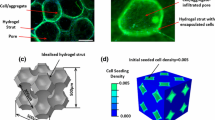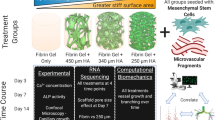Abstract
Mechanical stimuli such as tissue deformation and fluid flow are often implicated as regulators of mesenchymal stem cell (MSC) differentiation during regenerative events in vivo. However, in vitro studies have identified several other physical and biochemical environmental cues, such as substrate stiffness and oxygen availability, as key regulators of stem cell fate. Hypotheses for how MSC differentiation is regulated in vivo can be either corroborated or rejected based on the ability of in silico models to accurately predict spatial and temporal patterns of tissue differentiation observed experimentally. The goal of this study was to employ a previously developed computational framework to test the hypothesis that substrate stiffness and oxygen availability regulate stem cell differentiation during tissue regeneration within an implanted bone chamber. To enable a prediction of the oxygen levels within the bone chamber, a lattice model of angiogenesis was implemented where blood vessel progression was dependent on the local mechanical environment. The model successfully predicted key aspects of MSC differentiation, including the correct spatial development of bone, marrow and fibrous tissue within the unloaded bone chamber. The model also successfully predicted chondrogenesis within the chamber upon the application of mechanical loading. This study provides further support for the hypothesis that substrate stiffness and oxygen availability regulate stem cell differentiation in vivo. These simulations also highlight the indirect role that mechanics may play in regulating MSC fate by inhibiting blood vessel progression and hence disrupting oxygen availability within regenerating tissues.








Similar content being viewed by others
References
Appeddu PA, Shur BD (1994) Molecular analysis of cell surface beta-1,4-galactosyltransferase function during cell migration. Proceedings of the National Academy of Sciences of the United States of America 91(6):2095–2099
Armstrong CG, Mow VC (1982) Variations in the intrinsic mechanical properties of human articular-cartilage with age, degeneration, and water-content. J Bone Joint Surg Am 64(1):88–94
Bostrom MP, Lane JM, Berberian WS, Missri AA, Tomin E, Weiland A, Doty SB, Glaser D, Rosen VM (1995) Immunolocalization and expression of bone morphogenetic proteins 2 and 4 in fracture healing. J Orthop Res 13(3):357–367
Burke D, Dishowitz M, Sweetwyne M, Miedel E, Hankenson KD, Kelly DJ (2013) The role of oxygen as a regulator of stem cell fate during fracture repair in TSP2-null mice. J Orthop Res 31(10):1585–1596
Burke DP, Kelly DJ (2012) Substrate stiffness and oxygen as regulators of stem cell differentiation during skeletal tissue regeneration: a mechanobiological model. PLoS One 7(7):e4073
Byrne DP, Lacroix D, Planell JA, Kelly DJ, Prendergast PJ (2007) Simulation of tissue differentiation in a scaffold as a function of porosity, Young’s modulus and dissolution rate: application of mechanobiological models in tissue engineering. Biomaterials 28(36):5544–5554
Byrne DP, Lacroix D, Prendergast PJ (2011) Simulation of fracture healing in the tibia: Mechanoregulation of cell activity using a lattice modeling approach. J Orthop Res 29(10):1496–1503
Carter DR, Blenman PR, Beaupre GS (1988) Correlations between mechanical stress history and tissue differentiation in initial fracture healing. J Orthop Res 6(5):736–748
Checa S, Byrne DP, Prendergast PJ (2012) Predictive modelling in mechanobiology: combining algorithms for cell activities in response to physical stimuli using a lattice-modelling approach. Adv Struct Mater 1(1):423–435
Checa S, Prendergast PJ (2009) A mechanobiological model for tissue differentiation that includes angiogenesis: a lattice-based modeling approach. Ann Biomed Eng 37(1):129–145
Claes LE, Heigele CA (1999) Magnitudes of local stress and strain along bony surfaces predict the course and type of fracture healing. J Biomech 32(3):255–266
de Rooij PP, Siebrecht MA, Tagil M, Aspenberg P (2001) The fate of mechanically induced cartilage in an unloaded environment. J Biomech 34(7):961–966
Dupont S, Morsut L, Aragona M, Enzo E, Giulitti S, Cordenonsi M, Zanconato F, Le Digabel J, Forcato M, Bicciato S, Elvassore N, Piccolo S (2011) Role of YAP/TAZ in mechanotransduction. Nature 474(7350):179–183
Engler AJ, Sen S, Sweeney HL, Discher DE (2006) Matrix elasticity directs stem cell lineage specification. Cell 126(4):677–689
Epari DR, Lienau J, Schell H, Witt F, Duda GN (2008) Pressure, oxygen tension and temperature in the periosteal callus during bone healing-an in vivo study in sheep. Bone 43(4):734–739
Fehrer C, Brunauer R, Laschober G, Unterluggauer H, Reitinger S, Kloss F, Gully C, Gassner R, Lepperdinger G (2007) Reduced oxygen tension attenuates differentiation capacity of human mesenchymal stem cells and prolongs their lifespan. Aging Cell 6(6):745–757
Geris L, Gerisch A, Sloten JV, Weiner R, Oosterwyck HV (2008) Angiogenesis in bone fracture healing: a bioregulatory model. J Theor Biol 251(1):137–158
Geris L, Sloten JV, Van Oosterwyck H (2010a) Connecting biology and mechanics in fracture healing: an integrated mathematical modeling framework for the study of nonunions. Biomech Model Mechanobiol 9(6):713–724
Geris L, Van Oosterwyck H, Vander Sloten J, Duyck J, Naert I (2003) Assessment of mechanobiological models for the numerical simulation of tissue differentiation around immediately loaded implants. Comput Methods Biomech Biomed Eng 6(5–6):277–288
Geris L, Vandamme K, Naert I, Van Oosterwyck H, Duyck J (2010b) Mechanical loading affects angiogenesis and osteogenesis in an in vivo bone chamber: a modeling study. Tissue Eng Part A 16(11):3353–3361
Gomez-Benito MJ, Garcia-Aznar JM, Kuiper JH, Doblare M (2005) Influence of fracture gap size on the pattern of long bone healing: a computational study. J Theor Biol 235(1):105–119
Haudenschild AK, Hsieh AH, Kapila S, Lotz JC (2009) Pressure and distortion regulate human mesenchymal stem cell gene expression. Ann Biomed Eng 37(3):492–502
Hershey D, Karhan T (1968) Diffusion coefficients for oxygen transport in whole blood. AIChE J 14(6):969–972
Hirao M, Tamai N, Tsumaki N, Yoshikawa H, Myoui A (2006) Oxygen tension regulates chondrocyte differentiation and function during endochondral ossification. J Biol Chem 281(41):31079–31092
Holzwarth C, Vaegler M, Gieseke F, Pfister SM, Handgretinger R, Kerst G, Muller I (2010) Low physiologic oxygen tensions reduce proliferation and differentiation of human multipotent mesenchymal stromal cells. BMC Cell Biol 11:11
Hori RY, Lewis JL (1982) Mechanical properties of the fibrous tissue found at the bone-cement interface following total joint replacement. J Biomed Mater Res 16(6):911–927
Isaksson H, van Donkelaar CC, Huiskes R, Ito K (2006) Corroboration of mechanoregulatory algorithms for tissue differentiation during fracture healing: comparison with in vivo results. J Orthop Res 24(5):898–907
Isaksson H, van Donkelaar CC, Huiskes R, Ito K (2008) A mechano-regulatory bone-healing model incorporating cell-phenotype specific activity. J Theor Biol 252(2):230–246
Joyce ME, Roberts AB, Sporn MB, Bolander ME (1990) Transforming growth factor-beta and the initiation of chondrogenesis and osteogenesis in the rat femur. J Cell Biol 110(6):2195–2207
Kanichai M, Ferguson D, Prendergast PJ, Campbell VA (2008) Hypoxia promotes chondrogenesis in rat mesenchymal stem cells: a role for AKT and hypoxia-inducible factor (HIF)-1alpha. J Cell Physiol 216(3):708–715
Kelly DJ, Prendergast PJ (2005) Mechano-regulation of stem cell differentiation and tissue regeneration in osteochondral defects. J Biomech 38(7):1413–1422
Khayyeri H, Checa S, Tagil M, Aspenberg P, Prendergast PJ (2011) Variability observed in mechano-regulated in vivo tissue differentiation can be explained by variation in cell mechano-sensitivity. J Biomech 44(6):1051–1058
Khayyeri H, Checa S, Tagil M, Prendergast PJ (2009) Corroboration of mechanobiological simulations of tissue differentiation in an in vivo bone chamber using a lattice-modeling approach. J Orthop Res 27(12):1659–1666
Khayyeri H, Isaksson H, Prendergast PJ (2013) Corroboration of computational models for mechanoregulated stem cell differentiation. Comput Methods Biomech Biomed Eng. doi:10.1080/10255842.2013.774381
Knippenberg M, Helder MN, Wuisman PI, Klein-Nulend J (2006) Osteogenesis versus chondrogenesis by BMP-2 and BMP-7 in adipose stem cells. Biochem Biophys Res Commun 342(3):902– 908
Lacroix D, Prendergast PJ (2002) A mechano-regulation model for tissue differentiation during fracture healing: analysis of gap size and loading. J Biomech 35(9):1163–1171
Listrom RD, Symington JM, Albrektsson T (1988) A bone chamber for investigation of gas pressure. Oxygen tension measured in rabbits. Acta Orthop Scand 59(4):454–458
Loboa EG, Beaupre GS, Carter DR (2001) Mechanobiology of initial pseudarthrosis formation with oblique fractures. J Orthop Res 19(6):1067–1072
Marlovits S, Zeller P, Singer P, Resinger C, Vecsei V (2006) Cartilage repair: generations of autologous chondrocyte transplantation. Eur J Radiol 57(1):24–31
Meyer EG, Buckley CT, Thorpe SD, Kelly DJ (2010) Low oxygen tension is a more potent promoter of chondrogenic differentiation than dynamic compression. J Biomech 43(13):2516–2523
Ochoa JA, Hillberry BM (1992) Permeability of bovine cancellous bone. Trans of the 38th ORS:162
Park JS, Chu JS, Tsou AD, Diop R, Tang Z, Wang A, Li S (2011) The effect of matrix stiffness on the differentiation of mesenchymal stem cells in response to TGF-beta. Biomaterials 32(16):3921–3930
Pattappa G, Heywood HK, de Bruijn JD, Lee DA (2010) The metabolism of human mesenchymal stem cells during proliferation and differentiation. J Cell Physiol 226(10):2562–2570
Peiffer V, Gerisch A, Vandepitte D, Van Oosterwyck H, Geris L (2011) A hybrid bioregulatory model of angiogenesis during bone fracture healing. Biomech Model Mechanobiol 10(3):383–395
Perez MA, Prendergast PJ (2007) Random-walk models of cell dispersal included in mechanobiological simulations of tissue differentiation. J Biomech 40(10):2244–2253
Pittenger MF, Mackay AM, Beck SC, Jaiswal RK, Douglas R, Mosca JD, Moorman MA, Simonetti DW, Craig S, Marshak DR (1999) Multilineage potential of adult human mesenchymal stem cells. Science 284(5411):143–147
Prendergast PJ, Huiskes R, Soballe K (1996) Biophysical stimuli on cells during tissue differentiation at implant interfaces. J Biomech 30(6):539–548
Reina-Romo E, Gomez-Benito MJ, Dominguez J, Garcia-Aznar JM (2012) A lattice-based approach to model distraction osteogenesis. J Biomech 45(16):2736–2742
Street J, Bao M, deGuzman L, Bunting S, Peale FV Jr, Ferrara N, Steinmetz H, Hoeffel J, Cleland JL, Daugherty A, van Bruggen N, Redmond HP, Carano RA, Filvaroff EH (2002) Vascular endothelial growth factor stimulates bone repair by promoting angiogenesis and bone turnover. Proc Natl Acad Sci USA 99(15):9656–9661
Tagil M, Aspenberg P (1999) Cartilage induction by controlled mechanical stimulation in vivo. J Orthop Res 17(2):200–204
Takahashi I, Nuckolls GH, Takahashi K, Tanaka O, Semba I, Dashner R, Shum L, Slavkin HC (1998) Compressive force promotes sox9, type II collagen and aggrecan and inhibits IL-1beta expression resulting in chondrogenesis in mouse embryonic limb bud mesenchymal cells. J Cell Sci 111(Pt 14):2067–2076
Topol L, Chen W, Song H, Day TF, Yang Y (2009) Sox9 inhibits Wnt signaling by promoting beta-catenin phosphorylation in the nucleus. J Biol Chem 284(5):3323–3333
van der Meulen MC, Huiskes R (2002) Why mechanobiology? Survey article. J Biomech 35(4):401–414
Yun Z, Maecker HL, Johnson RS, Giaccia AJ (2002) Inhibition of PPAR[gamma]2 gene expression by the HIF-1-regulated gene DEC1/Stra13: a mechanism for regulation of adipogenesis by hypoxia. Dev Cell 2(3):331–341
Acknowledgments
Funding provided by a Science Foundation Ireland President of Ireland Young Researcher Award (08/Y15/B1336), a European Research Council Starter Grant (Stem Repair - No. 258463) and through a Trinity College Dublin Research Studentship Award.
Author information
Authors and Affiliations
Corresponding author
Rights and permissions
About this article
Cite this article
Burke, D.P., Khayyeri, H. & Kelly, D.J. Substrate stiffness and oxygen availability as regulators of mesenchymal stem cell differentiation within a mechanically loaded bone chamber. Biomech Model Mechanobiol 14, 93–105 (2015). https://doi.org/10.1007/s10237-014-0591-7
Received:
Accepted:
Published:
Issue Date:
DOI: https://doi.org/10.1007/s10237-014-0591-7




